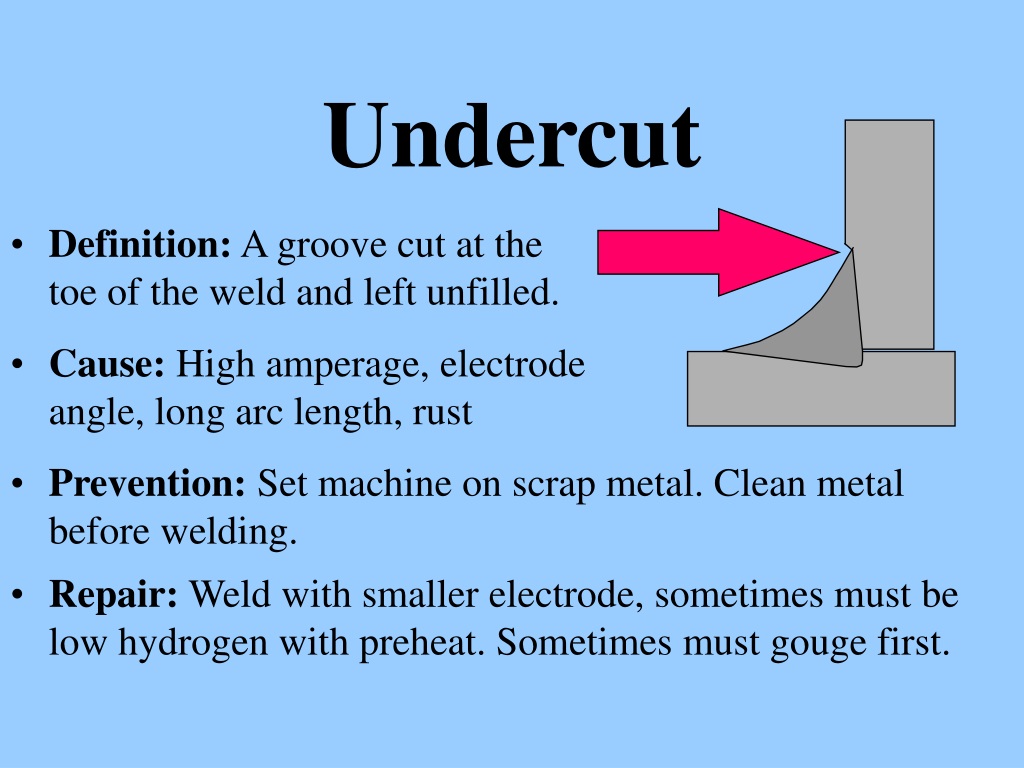Grasping the Art of Welding: Just How to Avoid Undercut Welding Issues for Flawless Fabrication Outcomes
Performance and precision are extremely important worldwide of welding, where also the smallest flaw can compromise the structural integrity of a made piece. One common challenge that welders face is undercutting, an issue that can lead and weaken a weld joint to expensive rework. By understanding the origin of undercut welding and carrying out reliable strategies to stop it, welders can raise their craft to brand-new levels of quality (Preventing weld undercut). In the pursuit of remarkable manufacture outcomes, understanding the art of welding to stay clear of undercut issues is not just a skill but a necessity for those pursuing excellence in their job.
Recognizing Undercut Welding

To avoid undercut welding, welders need to guarantee correct welding parameters, such as changing the existing, voltage, travel rate, and keeping the appropriate electrode angle. In addition, using the suitable welding strategy for the specific joint setup is crucial. Employing weaving movements or backstepping strategies can help ensure appropriate weld steel deposition and lower the likelihood of undercut formation. Routine examination of welds during and after the welding process is likewise vital to capture any undercut early and make required modifications to stop more defects. Preventing weld undercut. By comprehending the root causes of undercut welding and carrying out preventative actions, welders can achieve top quality, structurally sound welds.
Reasons of Undercut in Welding
Comprehending the factors that add to damage in welding is crucial for welders to generate high-grade, structurally audio welds. Damaging happens when the weld metal does not properly fill the groove created in between the base metal and the previously transferred weld steel. A number of factors can bring about damage in welding. One common reason is too much heat input. Welding at heats for extensive periods can result in the base steel melting even more than preferred, resulting in damage. Insufficient welding current or wrong welding rate can also add to damage. Inadequate current may not supply sufficient heat to thaw the base and filler metals adequately, while too much speed can protect against appropriate blend, triggering undercut. Additionally, incorrect electrode angles or incorrect lantern manipulation methods can create areas of reduced weld metal deposition, advertising undercut. Understanding these reasons and implementing appropriate welding strategies can assist protect against undercutting problems, guaranteeing solid and durable welds.
Techniques to stop Undercutting

To reduce the risk of undercutting in welding, welders can use strategic welding strategies intended at improving the high quality and integrity of the weld joints. Additionally, making use of the proper welding strategy for the certain joint setup, such as weave or stringer beads, can add to minimizing undercutting.
Additionally, proper joint prep work, consisting of guaranteeing clean base products complimentary of contaminants and using the ideal welding consumables, is vital in stopping undercut problems. Employing back-step welding methods and controlling the weld grain account can also aid distribute warmth uniformly and reduce the threat of undercut. Routine inspection of the weld joint throughout and after welding, as well browse around here as applying quality control steps, can assist in resolving and discovering undercutting problems promptly. By carrying out these techniques carefully, welders can achieve perfect manufacture results with very little undercut issues.
Relevance of Correct Welding Parameters
Choosing and preserving ideal welding check my source criteria is important for accomplishing effective welds with marginal issues. Welding parameters refer to variables such as voltage, current, travel speed, electrode angle, and protecting gas flow price that straight influence the welding procedure. These criteria should be thoroughly changed based upon the sort of product being bonded, its density, and the welding method used.
Correct welding criteria make certain the appropriate quantity of warmth is put on thaw the base steels and filler product consistently. If the specifications are set too expensive, it can result in extreme heat input, causing spatter, burn-through, or distortion. On the various other hand, if the criteria are as well low, incomplete fusion, absence of infiltration, or undercutting may occur.
Quality Control in Welding Workflow

Final Thought
Finally, understanding the art of welding needs an extensive understanding of undercut welding, its causes, and strategies to stop it. By ensuring correct welding parameters and applying quality control techniques, flawless manufacture results can be attained. It is vital for welders to consistently pursue excellence in their welding procedures to avoid undercut problems and produce top notch welds.
Undercut welding, a common issue in welding processes, occurs when the weld steel does not correctly load the groove and leaves a groove or anxiety along the bonded joint.To prevent undercut welding, welders must ensure appropriate welding criteria, such as adjusting the present, voltage, traveling speed, and preserving the proper electrode angle. Inadequate welding incorrect or present welding rate find out here now can also contribute to undercut.To reduce the risk of damaging in welding, welders can use strategic welding methods intended at boosting the top quality and integrity of the weld joints.In final thought, grasping the art of welding calls for a comprehensive understanding of undercut welding, its causes, and methods to stop it.